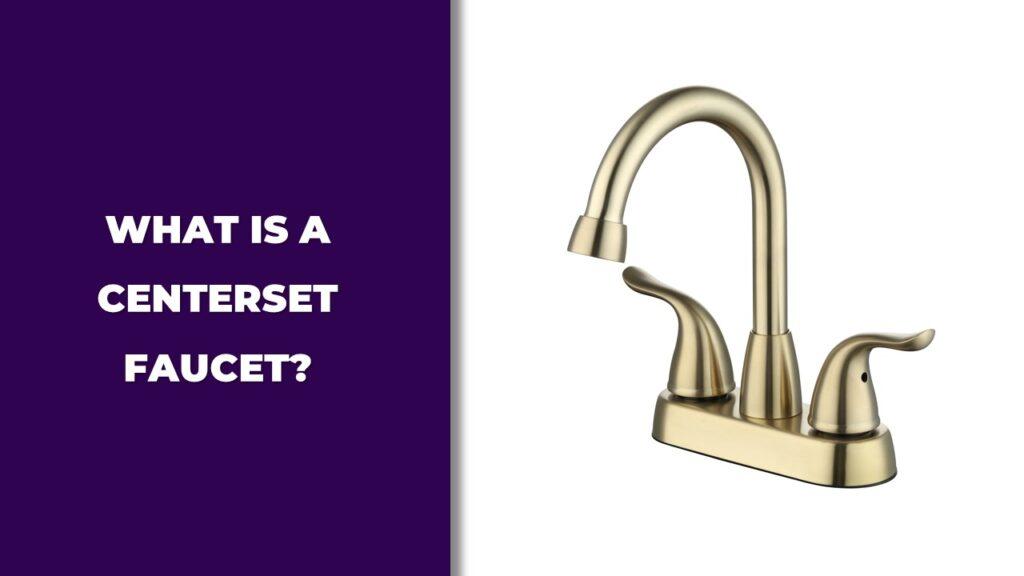
A centerset faucet is a compact bathroom faucet where the spout and handles are mounted together on a single base. It fits sinks with three holes spaced 4 inches apart, making it perfect for small bathrooms or powder rooms. The design is simple, with one spout and two handles (or sometimes a single lever), all connected as one unit.
This article will explain how centerset faucets work, where they fit best, how they compare to other faucet types, and the pros and cons of using them. You’ll also get tips on choosing the right one, plus installation and care advice.
What Makes a Faucet “Centerset”?
A centerset faucet is a type of bathroom faucet where the spout and handles are built into a single unit that fits sinks with three holes spaced 4 inches apart. The spout sits in the middle, while the hot and cold handles sit on either side, all on one base plate. This design makes it simple to install and a perfect fit for small bathrooms or powder rooms.
When you think about a centerset faucet, imagine a small, neat package that does everything in one spot. The spout delivers the water, and the handles give you control over the temperature. The single base plate keeps it all together, so there’s no juggling multiple pieces or worrying about tricky installation.
This design is popular because it’s practical and easy. If you’ve ever struggled with tight spaces or felt like your bathroom counter was too crowded, a centerset faucet might be just what you need. It’s all about keeping things clean, simple, and hassle-free.
Where You’ll Find Centerset Faucets
You’ll find centerset faucets in places where space is tight, and function comes first. These faucets are a go-to solution for bathrooms that need to stay simple and neat without giving up on style or ease of use.
Here are some common places where centerset faucets are a smart pick:
- Powder Rooms: Small spaces where every inch counts.
- Guest Bathrooms: A simple, reliable option that’s easy to maintain.
- Apartments or Rentals: Great for quick, budget-friendly upgrades.
- Older Homes: Many older sinks are made with a 4-inch hole pattern that perfectly fits centerset faucets.
- Public Restrooms: Easy to clean and less likely to cause maintenance headaches.
If your sink has three holes close together, a centerset faucet could be the perfect match.
Key Parts of a Centerset Faucet
A centerset faucet is made up of a few basic parts that work together to make your sink run smoothly. It’s a compact design, but every part has a job to do.
Here’s a quick breakdown of the main parts:
- Spout: This is where the water comes out.
- Handles: One for hot and one for cold water, or sometimes a single lever for both.
- Deck Plate (Escutcheon): The flat piece that holds the faucet together and covers the sink holes.
- Cartridges: Inside the handles, they control how much water flows and the temperature.
- Aerator: The mesh screen at the tip of the spout that helps control flow and prevent splashing.
Each part works together to give you easy control over water flow and temperature, all while keeping your sink looking tidy.
How to Identify a Centerset Faucet in Your Home
A centerset faucet is easy to spot once you know what to look for. It’s a single unit where the spout and handles are all attached to the same base, and it’s designed for sinks with three holes spaced 4 inches apart.
If you’re unsure whether your faucet is a centerset, grab a tape measure and check the distance between the centers of the two outer holes on your sink. If it measures 4 inches, that’s a centerset faucet.
Another easy clue? Look at the design. If the spout and handles are all one piece, you’ve got a centerset. If the spout and handles are separate and spread out, it’s a widespread faucet, not a centerset.
Centerset Faucet Sizing and Compatibility
A centerset faucet is designed to fit sinks with three holes that are spaced 4 inches apart. This 4-inch measurement is taken from the center of one hole to the center of the other. It’s a standard size found in many bathroom sinks, especially in smaller spaces.
Let’s break this down further.
What Is 4-Inch Faucet Spacing?
When we say “4-inch faucet spacing,” we’re talking about the distance between the center points of the two outer holes on the sink. This spacing is measured from the center of the left hole to the center of the right hole. If your sink has three holes in a row and they measure 4 inches across, it’s a match for a centerset faucet.
This measurement is important because a faucet designed for 4-inch spacing won’t fit properly in a sink made for a different setup.
Other Common Faucet Spacings
Besides the 4-inch spacing used for centerset faucets, you’ll see a few other common sizes:
- 8 inches or wider: These are for widespread faucets, where the handles and spout are installed separately.
- Single-hole: These are for faucets that have everything—spout and handle—in one spot, using just one hole in the sink.
- Mini-widespread (sometimes 4 inches): A smaller version of widespread, but designed to look more like separate pieces, even though they may still fit a 4-inch sink.
Each size works for different sink types, so it’s important to measure before you buy.
Will a Centerset Faucet Fit My Sink?
If your sink has three holes spaced 4 inches apart, a centerset faucet should fit just fine. Many standard bathroom sinks in homes, apartments, and rentals are made for this size.
But if your sink has wider spacing, like 8 inches or more, a centerset faucet won’t line up properly. The holes won’t match, and you’d need a widespread faucet instead.
Can I Replace a Widespread Faucet with a Centerset?
You can, but it might take some extra work. If your sink has 8-inch holes for a widespread faucet, and you want to switch to a centerset, you’d need a special deck plate or cover to hide the extra space.
Some homeowners do this to save money or simplify their faucet setup. But if you don’t want to mess with extra parts, sticking with the original size is usually the easier route.
Centerset Faucets vs. Other Faucet Types: A Clear Comparison
A centerset faucet is a compact, all-in-one faucet that fits 4-inch sinks, but there are other options to consider, too. Each type has its own look, feel, and level of complexity when it comes to installation.
Let’s take a closer look at how centerset faucets compare.
Centerset vs. Widespread Faucets
Widespread faucets have separate pieces for the spout and handles. The spacing between them can range from 8 to 16 inches, which makes them more flexible for larger sinks and bigger countertops.
Centerset faucets, on the other hand, are an all-in-one design. They are perfect for small sinks and tight spaces where you don’t have the room for wide-spread pieces. They’re also quicker to install since everything is connected on one base plate.
Centerset vs. Single-Hole Faucets
Single-hole faucets only need one hole in the sink. They combine the spout and the handle in a single, clean-looking unit. These are common in modern designs and small bathrooms.
Centerset faucets require three holes and give you separate handles for hot and cold water. They’re more traditional, while single-hole faucets lean towards a minimalist style.
Centerset vs. Mini-Widespread Faucets
Mini-widespread faucets are a bit like a hybrid. They look like widespread faucets, but they’re designed to fit into a 4-inch sink layout.
A centerset faucet is usually simpler to install and maintain. A mini-widespread might give you a bit more design variety, but it can be trickier to fit in tight spaces.
Centerset vs. Wall-Mounted Faucets
Wall-mounted faucets attach to the wall above the sink, not to the sink itself. They create a clean, floating look and free up counter space.
Centerset faucets are mounted directly to the sink or countertop. They’re a simpler option that works well for most standard sinks, while wall-mounted faucets need special plumbing and careful installation.
Pros and Cons of Centerset Faucets
A centerset faucet is a popular choice for a reason, but it’s not perfect for everyone. Let’s go over the good and the not-so-good sides so you can make the right call for your bathroom.
Advantages
- Space-saving design: Perfect for smaller sinks and tight spaces.
- All-in-one construction: Easier to install, fewer parts to worry about.
- Budget-friendly: Generally more affordable than widespread faucets.
- Wide variety of styles and finishes: Plenty of options to match your bathroom.
- Fewer leaks: Since everything is connected, there are fewer joints that might leak.
Disadvantages
- Less customization: Handles are fixed in place, so you can’t move them around.
- Harder to clean around the base: The compact design means tight spots where grime can build up.
- Full replacement for issues: If part of it breaks, you usually have to replace the whole unit.
- Not ideal for large sinks: They might look too small or get lost on a big vanity.
When a Centerset Faucet Is the Best Choice
A centerset faucet is a great pick when you have a 4-inch sink, limited counter space, or you just want something simple that works. They’re a solid choice for powder rooms, guest bathrooms, and even kids’ bathrooms where function and ease of use are more important than a fancy look.
How to Choose the Right Centerset Faucet for Your Bathroom
To choose the right centerset faucet for your bathroom, first check your sink’s hole pattern, then consider the handle style, finish, water efficiency, and quality of materials. A good faucet should fit your sink perfectly, match your bathroom’s style, and be easy to use.
Here’s what to keep in mind when picking the right faucet:
- Consider Your Sink’s Hole Pattern and Size: Make sure your sink has three holes spaced 4 inches apart, which is standard for centerset faucets. Double-check the size and shape of your sink area so the faucet doesn’t look too big or too small.
- Pick a Handle Style: Centerset faucets can have one handle that controls both hot and cold water, or two separate handles. Think about what feels easiest to use in your space.
- Choose a Finish That Matches Your Décor: Finishes like chrome, brushed nickel, or matte black can help tie the faucet into the rest of your bathroom. Pick one that looks good with your sink, hardware, and fixtures.
- Look for Water-Saving Features: If you want to save water, look for a faucet that’s WaterSense certified. This means it’s designed to use less water without sacrificing performance.
- Check for Quality Indicators: Look for solid materials like brass or stainless steel and ceramic disc valves. These are more durable and less likely to leak over time. If you’re dealing with hard water issues in your home, it’s a good idea to check out kitchen faucets designed for hard water to avoid future clogs and damage.
How to Install a Centerset Faucet: Step-by-Step Guide
Installing a centerset faucet is usually a simple task, especially since the spout and handles are combined into one piece. Just take your time, use the right tools, and follow these steps carefully.
Tools You’ll Need:
- Basin wrench
- Adjustable wrench
- Plumber’s tape
- Plumber’s putty (optional)
- Bucket and towels
Here is the step-by-step process to install a centerset faucet:
Step 1: Turn Off the Water Supply
Find the shut-off valves under the sink and turn them clockwise to stop the water. Open the old faucet to release any water left in the lines.
Step 2: Remove the Old Faucet
Place a bucket or towel under the sink to catch any water drips. Use a wrench to loosen the nuts holding the old faucet in place. Once it’s loose, lift the old faucet out of the sink.
Step 3: Clean the Sink Surface
Wipe down the area around the faucet holes. Remove any old putty or residue so the new faucet can sit flush.
Step 4: Position the New Centerset Faucet
Place the new faucet into the sink holes, making sure the connections line up properly. The spout and handles should sit evenly across the sink.
Step 5: Secure the Faucet
From underneath the sink, screw the mounting nuts onto the faucet connections. Use a basin wrench to tighten them snugly, but don’t over-tighten—this can crack parts.
Step 6: Attach the Water Supply Lines
Connect the hot and cold water lines to the matching valves under the sink. Wrap plumber’s tape around the threaded connections before tightening to help prevent leaks.
Step 7: Turn the Water Back On
Slowly turn the shut-off valves counterclockwise to restore the water supply. Turn on the faucet and check for any leaks around the connections.
Step 8: Check Your Work
Let the water run for a few minutes. Check under the sink and around the faucet for any signs of drips or leaks. If you spot a leak, turn off the water and tighten the connections a little more.
Common Installation Mistakes to Avoid
- Don’t over-tighten connections, as this can damage parts.
- Always use plumber’s tape on threaded connections.
- Double-check alignment before fully tightening the faucet.
When to Call a Professional
If your plumbing setup is older, corroded, or you’re unsure about something, it’s smart to call a plumber. They can make sure the job is done safely and avoid any unexpected problems.
Maintenance and Troubleshooting for Centerset Faucets
Taking care of your centerset faucet is simple if you clean it regularly and fix small issues as they pop up. A little attention now and then can keep it working well for years.
Here’s how to keep your faucet in good shape:
- Routine Care Tips: Wipe down your faucet regularly with a soft cloth and mild soap. Avoid harsh cleaners that can damage the finish. Check the handles and spout for water spots or buildup.
- Common Problems and Fixes: If your faucet drips, it might need a new cartridge or washer. If the water pressure is low, clean the aerator. For handles that feel stiff or hard to turn, try loosening the handle screws or adding a little silicone grease.
- When to Replace Your Centerset Faucet: If your faucet has frequent leaks, corrosion, or worn-out parts, it may be time for a new one. Sometimes replacing the whole faucet is quicker and less expensive than fixing multiple problems.
Final Thoughts
A centerset faucet is a simple, space-saving option that works well for small bathrooms and powder rooms. It’s designed for sinks with three holes spaced 4 inches apart, which is a common setup in many homes. If you’re looking for a faucet that’s easy to install, budget-friendly, and available in a variety of styles, a centerset faucet is a solid choice.
Centerset faucets are great when you want a functional, all-in-one design. They combine the spout and handles into a single unit, making it easier to keep your sink area neat and tidy. Plus, they’re easy to find in different finishes like chrome, brushed nickel, and matte black.
Whether you’re doing a quick bathroom update or replacing an old faucet, a centerset faucet is a practical option. It fits standard 4-inch sinks, works well in smaller spaces, and is often more affordable than other faucet types. If you need a reliable and easy-to-install faucet for your bathroom, a centerset model is worth considering.
Related FAQs
How do I know if I have a centerset faucet?
Check your sink. If it has three holes spaced 4 inches apart and the spout and handles are connected on a single plate, it’s a centerset faucet.
Can I replace a widespread faucet with a centerset faucet?
You can, but you’ll need to cover the extra holes in the sink. A deck plate or escutcheon can help hide them.
Are centerset faucets good for small bathrooms?
Yes, centerset faucets are ideal for small bathrooms because they save space and fit standard 4-inch sinks.
Do centerset faucets come in modern styles?
Yes, they’re available in many styles and finishes, from traditional to modern designs like matte black and brushed nickel.
Is it hard to install a centerset faucet?
No, installing a centerset faucet is usually straightforward, thanks to the all-in-one design. Just follow the steps and take your time.

Dylan Foster is a family man with years of hands-on experience in plumbing, household maintenance, and fixing everyday issues around the home. A former plumber, Dylan knows what it’s like to deal with tricky leaks, worn-out parts, and all the little problems that pop up in a house. From plumbing repairs to kitchen fixes and garden hose setups, he’s done it all. Dylan shares real-world solutions to help others keep their homes running smoothly and avoid costly mistakes.




